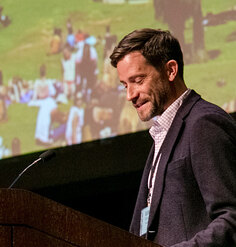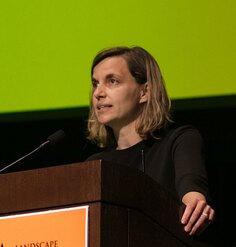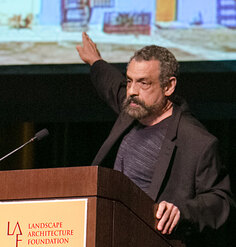The Landscape Architect as Urbanist of Our Age
By Charles Waldheim
This presentation was part of the Landscape Architecture Foundation’s The New Landscape Declaration: A Summit on Landscape Architecture and the Future held in Philadelphia on June 10-11, 2016. LAF asked a diverse group of leading minds to write a “Declaration” reflecting on the last half century and offering bold ideas for how landscape architecture can make its vital contribution in response to the challenges of our time.
Charles Waldheim
Professor, Harvard Graduate School of Design
Cambridge, Massachusetts
Charles Waldheim is John E. Irving Professor of Landscape Architecture at Harvard Graduate School of Design where he directs the school's Office of Urbanization. Waldheim serves as Ruettgers Curator of Landscape at the Isabella Stewart Gardner Museum.
The Landscape Architect as Urbanist of Our Age
by Charles Waldheim
The anniversary of the founding of the Landscape Architecture Foundation (LAF) and the original LAF 1966 Declaration of Concern invites us to revisit the identity and aspirations of the field itself. The founders of the so-called new art of landscape architecture specifically identified architecture as the most appropriate cultural identity for the new professional. In so doing, they proposed an innovative and progressive professional identity. This new liberal profession was founded during the second half of the nineteenth century in response to the social, environmental, and cultural challenges associated with the industrial city. In this milieu, the landscape architect was conceived as the professional responsible for the integration of civil infrastructure, environmental enhancement, and public improvement in the context of ongoing industrialization.
American boosters of the new art of landscape committed the nascent profession to an identity associated with the old art of architecture. The decision to identify architecture (as opposed to art, engineering, or gardening) as the proximate professional peer group is significant for contemporary understanding of landscape architecture. This history sheds compelling light on the subsequent development of city planning as a distinct professional identity spun out of landscape architecture in the first decades of the twentieth century, as well as on debates regarding landscape as a form of urbanism at the beginning of the twenty-first century.
This line of inquiry points toward the long-standing lineage of ecologically informed regional planning that grew out of the origins of landscape architecture in the first half of the twentieth century. That tradition evolved in the reformulation of landscape architecture as a highly technical and specialized branch of environmental science in the second half of the twentieth century. It was in part based on the sense of landscape architecture’s potential as a scientific activity that many of the original declarations were framed. Over the last half century, this position has come to stand for an empirically informed planning process dependent upon a robust welfare state for implementation.
For a generation of landscape architects trained primarily as environmental advocates, this approach proved to be an unfortunate detour en route to the anticipated enlightened future of rationally informed ecological planning of urban form. In too many contexts, rational ecological planning came to be perceived, rightly or not, as anti-urban. It was equally received in many contexts as transcendentalist and ultimately rather anti-intellectual. The commitment of the identity of the field to a subdisciplinary sphere of environmental science also came to be seen as less than pragmatic in the context of a withering welfare state and the rise of a neoliberal economy.
The recent renewal of landscape’s relevance in discussions of contemporary urbanism has little to do with ecologically informed regional planning and much more to do with an understanding of contemporary design culture. Today, the challenges of urbanization are less about the strengths of empirical knowledge and scientific method and more about the political failures of a culture that has largely abandoned welfare-state expectations of rationally informed ecological planning. Landscape’s recent renewed relevance to urbanism, instead of originating in the long-standing tradition of environmentally informed regional and urban planning, springs from landscape’s recent rapprochement with design culture.
In many ways, the contemporary interests of the most recent generation of leading landscape designers originated within architectural discourse during the past quarter century, as if postmodernism has finally come to landscape. Not surprising, many of those leading landscape architects began their education in landscape ecology, only to have that knowledge catalyzed by architectural theory. The generation of landscape architects and urbanists trained in this way exhibits a tendency to combine several seemingly contradictory understandings of ecology. Many contemporary landscape designers deploy ecology as a model of urban forces and flows, as a medium for deferred authorship in design, and as a rhetorical device for public reception and audience participation. They also have recourse to the traditional definition of ecology as the scientific study of species in relation to their habitats, often in service to a larger cultural or design agenda. In addition to its status as a model, ecology has come to be an equally effective metaphor for a range of intellectual and disciplinary pursuits.
Ecology is relevant as an epistemological framework operating at the level of a metaphor in the social or human sciences, the humanities, history, philosophy, and the arts. This metaphorical understanding of ecology has been particularly significant as it has been absorbed into the discourse around design. While landscape architecture and urban planning have historically tended to view ecology as a kind of applied natural science, architecture and the arts have received ecology as a metaphor imported from the social sciences, humanities, and philosophy. In the most intriguing of contemporary urban projects conceived through this understanding, urban form is given not through planning, policy, or precedent but through the autonomous self-regulation of emergent ecologies. In many examples, the ultimate urban figure is attained not through design but through the agency of ecological process directed toward social, political, and cultural ends.
A survey of contemporary landscape design practices internationally offers a provisional thesis: landscape design strategies often precede planning. Frequently, ecological understandings inform urban order, and design agency propels a process through a complex hybridization of land use, environmental stewardship, public participation, and design culture. In these projects, a previously extant planning regime is often rendered redundant through a design competition, donor’s bequest, or community consensus. The landscape architect, operating as an urbanist, reconceives the urban field, reordering the economic and the ecological, the social and the cultural, in service to a newly configured urban condition. Collectively, these practices represent the landscape architect acting as the urbanist of our age.











